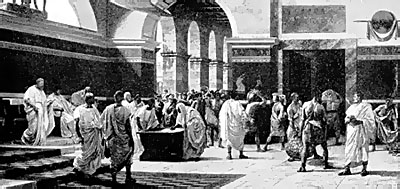
The Diribitorium was the building where a committee of 900 election officials (diribitores) counted the votes cast by the people in the Saepta (the technical term was diribere, to sort out). Earlier archaeologists, relying on the testimony of Cassius Dio (LV.8; LVI.24), believed that the Diribitorium was an adjacent yet separate building from the Saepta. Others, however, have suggested that the massive masonry of the building can only be justified if it is placed on the second floor of the Saepta (Platner & Ashby, 151). Then one can easily understand how the enormous beams that were associated with the structure could fit in a hall like that.
The building was finished in the time of Augustus in 7 BCE (Cass. Dio LV.8). It was famous for its roof with an extremely wide span, which was supported by beams one hundred feet long and one and a half feet thick. One of those beams had survived the fire that destroyed the rest of the building in 80 CE (Cass. Dio LXVI.24); it was kept in an exhibit in the Senate building as a curiosity. Cassius Dio mentions that still in his day (third century CE) the restored Diribitorium remained without a roof, because they could not find beams long enough to rebuild it.
After the imperial period, when the building lost its significance as a voting place, the Diribitorium was used for a variety of purposes. Caligula, for example, furnished it with benches and used it as an indoors theater when the sun was too hot to hold the performances outside (Cass. Dio LIX.7).
Click here for a coin (silver denarius) from 63 BCE that shows a citizen voting; he is in the process of dropping a tablet inscribed V into a cista (learn more about the Roman "yes" and "no" votes). Now it is time for you to vote and determine once and for all an age-old question. The rogatores (election officials) are asking for your opinion:
SHOULD LATIN BECOME A REQUIRED LANGUAGE AT SCHOOLS ALL OVER THE WORLD?